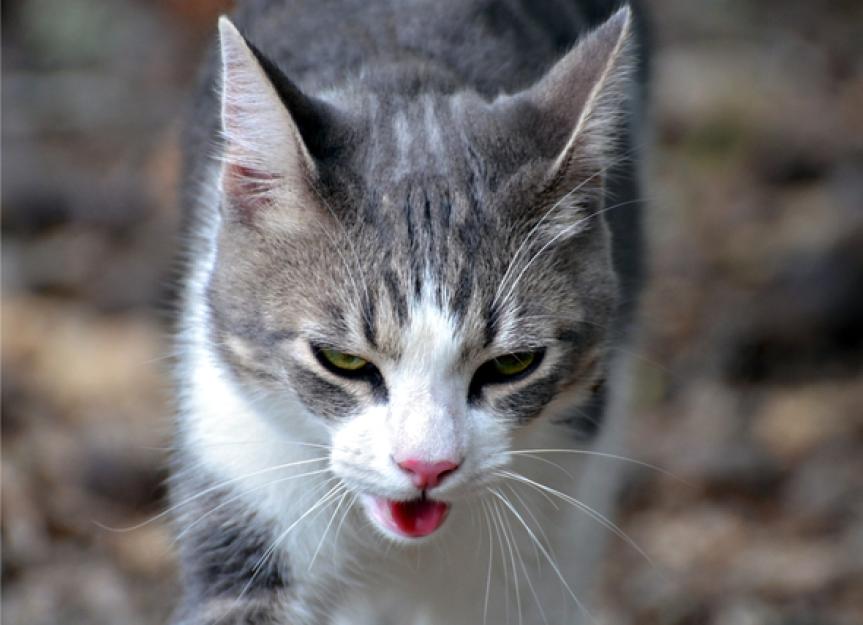Heat Stroke in Cats
Hyperthermia in Cats
In spite of their reputation as desert animals, cats do not tolerate heat any better than people. Cats only pant or sweat through their foot pads in order to get rid of excess heat. As the body temperature rises, the cat will suffer heat exhaustion and eventually heat stroke. If the body temperature is not brought down quickly, serious organ damage or death could result.
What to Watch For
Initial signs that typically indicate the heat is causing him some distress (heat stress) include:
- Restless behavior as your cat tries to find a cool spot
- Panting, sweaty feet, drooling, excessive grooming in an effort to cool off
- Rectal temperature is usually normal to slightly elevated
Then, as your cat’s body temperature begins to rise, signs of heat exhaustion become evident, including:
- Rapid pulse and breathing
- Redness of the tongue and mouth
- Vomiting
- Lethargy
- Stumbling, staggering gait
- Rectal temperature is over 105° F
Eventually the body temperature will be high enough to cause the cat to collapse and have seizures or slip into a coma.
Primary Cause
Excessive environmental temperature, with or without excessive humidity, and without access to a cool shaded area or water, will eventually lead to heat stroke.
Immediate Care
If your cat is found unconscious in a hot environment, soak him with cool (not cold) water, being careful to keep the water out of the nose and mouth. Place a bag of ice or frozen veggies between the legs and get your cat to the veterinarian immediately.
If your cat is still conscious but showing signs of heat exhaustion, immediately take him to a cool environment, soak him with cool water and let him drink all the water that he wants. Then, take him to veterinarian immediately.
If your cat is just starting to show signs of being stressed by the heat, move him to a cool quiet place and be sure he has plenty of water.
If you can do so safely, check your cat’s temperature with a rectal thermometer:
- 100° to 103° F is normal to slightly elevated
- 103° to 104° F is elevated and requires evaluation by a veterinarian
- Over 105° F is potentially life threatening and requires immediate care
Veterinary Care
Diagnosis
Diagnosis of heat exhaustion or heat stroke is based on a high rectal temperature (over 105° F) with a history of being in a hot environment and symptoms like those already described above. Your veterinarian will want to evaluate your cat to be sure this is not a fever due to infection.
Treatment
In addition to the cool water and ice as already described, the veterinarian will place an intravenous (IV) line to run cool fluids directly into your cat. This will not only help to lower your cat’s temperature, it will help to counteract the effects of shock and minimize the risk of organ damage, which can be brought on by high body temperature.
Your cat’s temperature will be monitored frequently until the temperature begins to fall. Once it has fallen sufficiently, the cooling efforts will be gradually stopped to prevent excessive cooling (hypothermia). Prolonged high body temperature can lead to organ damage and failure, especially of the brain. Your veterinarian will want to keep your cat until his temperature is stable, and he can be evaluated for signs of organ damage.
Other Causes
过度的压力,焦虑,或运动可以带来on hyperthermia. Cats with a short face (like Persians) or that are obese do not tolerate heat well and are more likely to develop hyperthermia.
Living and Management
Usually once the temperature is stabilized, no further treatment is needed. It may take several days for evidence of organ damage to develop, so if your cat does not seem completely back to normal within 2 or 3 days, talk to your veterinarian about your concern. Any aftercare prescribed by your veterinarian should be followed.
Prevention
Be sure your cat always has access to cool shady areas and plenty of water. Never leave her confined in a car unattended, or anywhere else that she can’t escape the sun or heat. Keep her inside on very hot days.
Help us make PetMD better
Was this article helpful?
